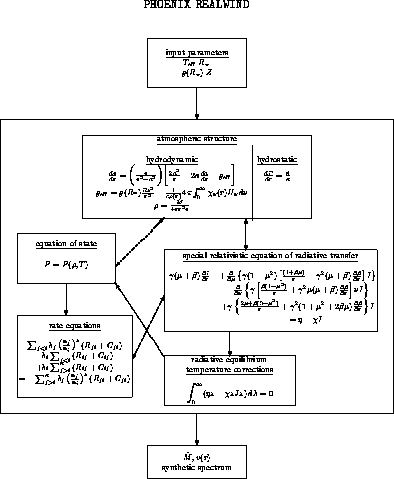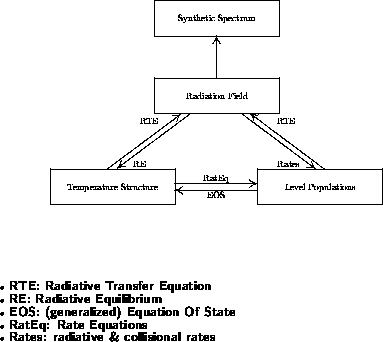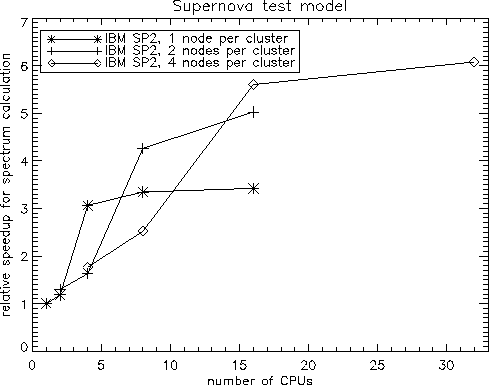


Next: About this document ...
Up: Numerical Solution of the
Previous: Discussion and Conclusions
- 1
-
Hauschildt, P. H.
JQSRT 47, (1992) 433.
- 2
-
Hauschildt, P. H.
JQSRT 50, (1993) 301.
- 3
-
Hauschildt, P. H. and Baron, E.
JQSRT 54, (1995) 987.
- 4
-
Hauschildt, P. H., Starrfield, S., Shore, S. N., Allard, F., and Baron, E.
ApJ 447, (1995) 829.
- 5
-
Allard, F. and Hauschildt, P. H.
ApJ 445, (1995) 433.
- 6
-
Hauschildt, P. H., Baron, E., Starrfield, S., and Allard, F.
ApJ 462, (1996) 386.
- 7
-
Baron, E., Hauschildt, P. H., Nugent, P., and Branch, D.
MNRAS 283, (1996) 297.
- 8
-
Hauschildt, P. H., Baron, E., and Allard, F.
ApJ 483, (1997) 390.
- 9
-
Baron, E. and Hauschildt, P. H.
Parallel implementation of the PHOENIX generalized stellar
atmosphere program. II: Wavelength parallelization.
ApJ 495, (1998) 370.
- 10
-
Message Passing Interface Forum.
MPI: A Message-Passing Interface Standard, Version 1.1 (Univ.
of Tennessee, Knoxville, TN, 1995).
- 11
-
Mihalas, D.
Stellar Atmospheres (W. H. Freeman, New York, 1978), second
edn.
- 12
-
Magnan, C.
JQSRT 10, (1970) 1.
- 13
-
Caroff, L. J., Noerdlinger, P. D., and Scargle, J. D.
ApJ 176, (1972) 439.
- 14
-
Auer, L. H. and Blerkom, D. V.
ApJ 178, (1972) 175.
- 15
-
Castor, J. I.
MNRAS 149, (1970) 111.
- 16
-
Mihalas, D., Kunasz, P., and Hummer, D.
ApJ 202, (1975) 465.
- 17
-
Hauschildt, P. H. and Wehrse, R.
JQSRT 46, (1991) 81.
- 18
-
Hauschildt, P. H., Best, M., and Wehrse, R.
A&A 247, (1991) L21.
- 19
-
Cannon, C. J.
JQSRT 13, (1973) 627.
- 20
-
Scharmer, G. B.
In W. Kalkofen, ed., Methods in Radiative Transfer (Cambridge
Univ. Press, Cambridge, 1984) p. 173, p. 173.
- 21
-
Olson, G. L., Auer, L. H., and Buchler, J. R.
JQSRT 38, (1987) 431.
- 22
-
Hamann, W.-R.
In Kalkofen [36] p. 35, p. 35.
- 23
-
Werner, K.
In Kalkofen [36] p. 67, p. 67.
- 24
-
Olson, G. L. and Kunasz, P. B.
JQSRT 38, (1987) 325.
- 25
-
Hauschildt, P. H., Störzer, H., and Baron, E.
JQSRT 51, (1994) 875.
- 26
-
Mihalas, D. and Mihalas, B. W.
Foundations of Radiation Hydrodynamics (Oxford University,
Oxford, 1984).
- 27
-
Mihalas, D.
ApJ 237, (1980) 574.
- 28
-
Golub, G. H. and Loan, C. V.
Matrix computations (The Johns Hopkins University Press,
1989).
- 29
-
Turek, S.
preprint, (1993).
- 30
-
Ng, K. C.
J. Chem. Phys. 61, (1974) 2680.
- 31
-
Vinsome, P. W.
In Proc. of the 4th Symp on Reservoir Simulation . Soc. of
Petroleum Engineers, (1976) p. 149, p. 149.
- 32
-
Auer, L.
In L. Crivellari, I. Hubeny, and D. G. Hummer, eds., Stellar
Atmospheres: Beyond Classical Models (NATO ASI Series, Kluwer, Dordrecht,
1991) p. 9, p. 9.
- 33
-
Rybicki, G. B. and Hummer, D. G.
A&A 245, (1991) 171.
- 34
-
Mihalas, D.
Stellar Atmospheres (W. H. Freeman, New York, 1970), first
edn.
- 35
-
Unsöld, A.
Physik der Sternatmosphären (Springer Verlag, Heidelberg,
1968), second edn.
- 36
-
Kalkofen, W., ed.
Cambridge, (1987). Cambridge Univ. Press.
Figure 1:
Relation between (some of) the physical and mathematical
blocks that describe the physics of a stellar atmosphere. In order
to calculate a model atmosphere, a set of value of the physical
variables, e.g., temperatures, densities, population densities and
the radiation field, must be found that satisfies all constraints
simultaneously.
 |
Figure 2:
Relations between the main types of variables
represented by blocks are indicated. The labels name the equations
that relate the block to each other.
 |
Figure 3:
The basic ``torus'' design of the wavelength-parallelized version of
PHOENIX: groups of processors are divided up into wavelength clusters which
will work on individual wavelength points, each wavelength cluster is further
divided into a set of worker nodes, where each worker node is assigned a set of
specific tasks, e.g., it will work on the LTE background line opacity for a set
of radial points. Our design requires that each worker node on all wavelength
clusters work on exactly the same set of tasks, although additional inherently
serial operations can be assigned to one particular master worker, or master
wavelength cluster. This reduces communication between clusters to its absolute
minimum and allows the maximum speedup.
 |
Figure 4:
Scalability of the Supernova model atmosphere test run
as function of the number of nodes (processing elements or nodes) used.
The y-axis gives the speedup obtained relative to the serial run. The
different symbols show the results for different numbers of worker tasks
for each wavelength cluster.
 |



Next: About this document ...
Up: Numerical Solution of the
Previous: Discussion and Conclusions
Peter H. Hauschildt
8/20/1998


